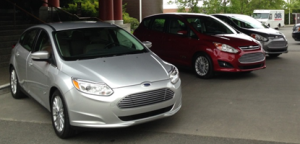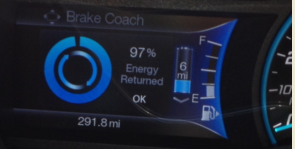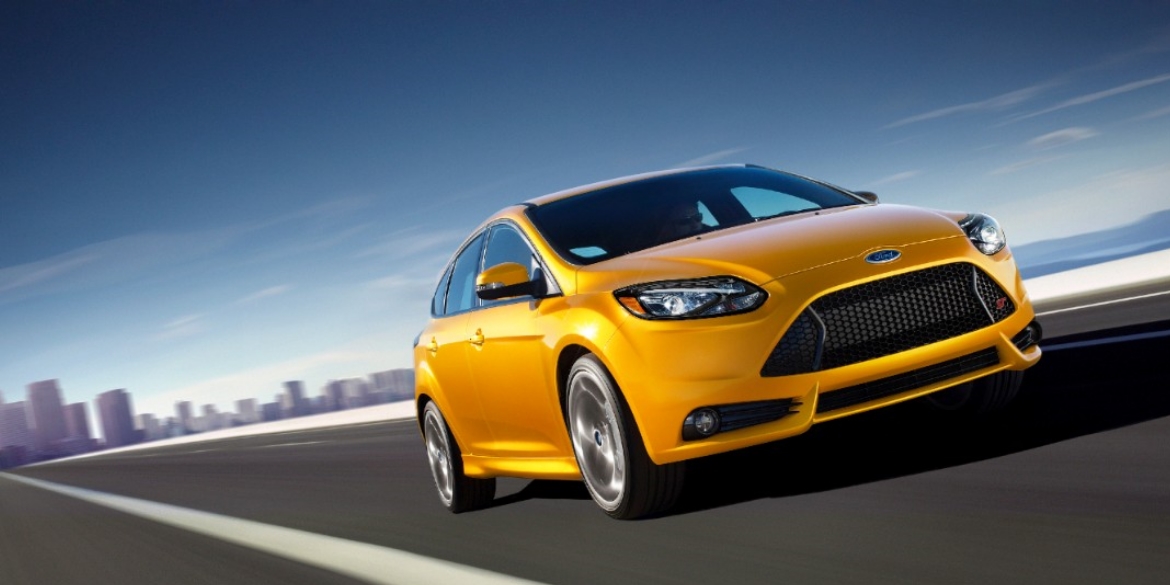For software guys like us, 7:15 AM is a bit early for a presentation and test drive, but we couldn’t resist the chance to check out some of Ford’s latest electric vehicle (EV) and plug-in hybrid electric vehicle (PHEV) advances last week at their Power of Choice event in Seattle. Despite the early hour, the discussion proved valuable not only in learning about what Ford is doing to give drivers a smarter driving experience, but how that relates to the work we, as a software company, are doing to bring intelligence to the energy industry—and what that means to energy consumers.

A Ford Focus Electric, C-MAX Energy and C-MAX Hybrid outside Palisade restaurant in Seattle on May 30, 2013
Mark Liffmann and I joined about twenty others at Palisade restaurant for the event. Ford sent two representatives from its Dearborn headquarters: Dr. Mazen Hammoud and Bill Frykman. Mazen is the chief engineer for Electrified Powertrain Systems and Bill is a product and business development manager who oversees MyFord Mobile. MyFord Mobile is the group at Ford that is working on bringing additional intelligence, connectivity, enhanced usability, remote control* and monitoring to its EV and PHEV lineup.
Ford thankfully pepped us up with caffeine and breakfast before Mazen and Bill gave us the rundown on the vehicles and Ford’s approach. Having Bill and Mazen there was a real treat as they are founts of knowledge about the minutiae of the vehicles. The audience—populated in no small part by veteran EV folks (think guys who built their own EVs twenty years ago)—took advantage of that fact to ask some in-depth questions. Some of the things we heard are relatively well known but nevertheless impressive:
- 85 mph top speed in electric-only mode for the C-MAX Energi…this makes it the industry standard-bearer for top speed among PHEVs
- 620 mile (!) combined – full fuel tank + full charge – range for the Fusion Energi
Other things, like the automatic ability to intelligently switch to all-electric (battery depletion) mode as the car moves toward home, were new to me. This feature works under the presumption that the car will be plugged-in once it arrives home—with ‘home’ defined by stored routes or information transmitted from MyFord Mobile—so the most economical thing is to use whatever power is in the battery.
One aspect of the discussion that felt familiar to me is the risk of negative perceptions around “loss of control” based on some of these integrated smarts and automated decision-making. Within the energy industry this is a common concern around “smart grid” technology: the consumer perception that they may not be able to do what they want, when they want, if they are at the whim of an enigmatic and unpredictable smart grid controlling their appliances. Similarly, drivers generally want their cars to react predictably, and ultimately they want to be in control.
The good news is that the auto industry probably has more experience with this kind of automated decision-making—and in very, very serious circumstances (think keeping your car upright and on the road)—than any other industry, with the possible exception of aviation (e.g., autopilots). The textbook example of this is traction and stability control systems. These systems dramatically reduce the likelihood of a range of dangerous situations such as rollovers, skids, over/under-steer situations (i.e., “fishtailing” or “plowing”), etc. More recent systems warn or even actively remediate for things like lane departures and unsafe follow distance. When the car is braking, accelerating or steering on your behalf, I think you have to agree that it’s making decisions for you.
The automakers have, in general, designed these safety related systems to be default on and not necessarily intuitive or easy to turn off. In fact, some systems, like the now nearly ubiquitous anti-lock braking systems (ABS), often cannot be disabled at all. Even for systems that can be disabled, they error on returning to “safety on” mode. For instance, that “Trac” or “TCS” button on your dash that you probably never press disables traction or stability control, but almost certainly only for that driving session. Once you power-cycle the car (so to speak), traction control is going to be back on and back protecting you.
That’s fine for safety systems; the 99% case for most drivers in most driving situations is that they want those things. The 1% may be track, auto-cross or other special situations. Have you tried drifting your minivan lately? You’ll need to turn traction control off.
But what about systems that have more to do with convenience, savings or the environment than with keeping you alive? Ford’s philosophy has been to put the driver in control and make those preferences and choices readily accessible. That is, Ford has made it trivial for the driver to relay his or her desires to the car. Want to drive EV only? Press the EV-only button. While Ford may be further along than its competition in integrating and connecting smarts in the car, in devices and in the cloud, and while they are doing impressive things (some of which are yet to come) with context (things like routes, regular stops, calendars/schedules, etc.), one thing is clear: the driver is in control.

The ‘Brake Coach’ efficiency screen in the Ford C-MAX Energi helps drivers maximize the vehicle’s efficiency.
Of course, the bulk of those smarts come from software and the context comes from data—some from humans, some from sensors and some from both. The advances and feature design choices we’ve seen from companies like Ford in hybrids, EVs and PHEVs, are valuable lessons and maybe even precedents for us at Clean Power Research as we build the software-powered analytics behind increasingly intelligent energy systems. Like Ford, we are wise to be thoughtful about who will use those systems and how they will be used, whether by a harried parent just trying to do a load of laundry, or a utility operator ramping up resources to meet a sudden spike in demand.
*As far as I know, you can’t drive the car from the phone, though that would be one heck of an Easter Egg. The remote control referred to here includes things like charge settings (e.g., “value charging”) and pre-conditioning the car before driving by, for example, heating or cooling the car.
